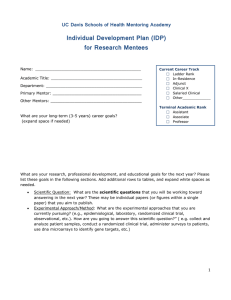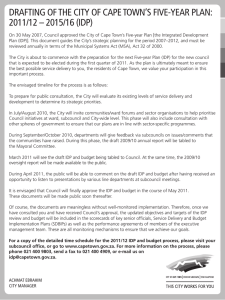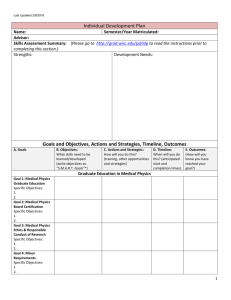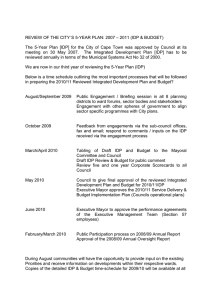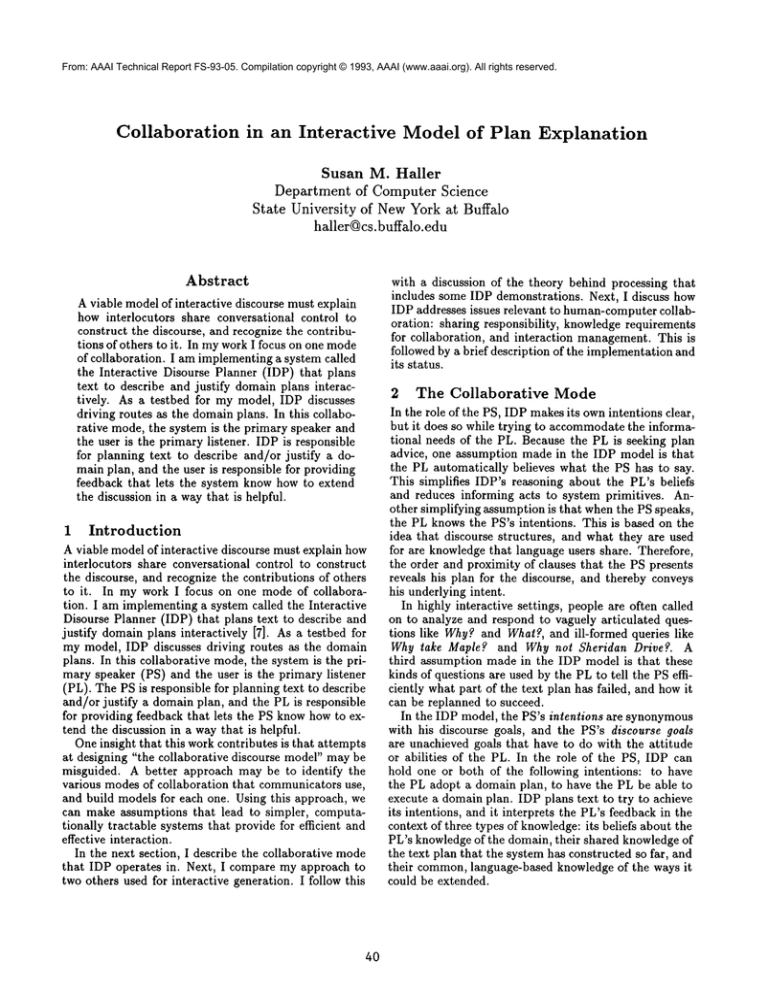
From: AAAI Technical Report FS-93-05. Compilation copyright © 1993, AAAI (www.aaai.org). All rights reserved.
Collaboration
in an Interactive
Model of Plan Explanation
Susan M. Hailer
Department
of Computer Science
State University
of New York at Buffalo
haller@cs.buffalo.edu
Abstract
A viable model of interactive discourse must explain
how interlocutors share conversational control to
construct the discourse, and recognize the contributions of others to it. In mywork I focus on one mode
of collaboration. I am implementing a system called
the Interactive Disourse Planner (IDP) that plans
text to describe and justify domain plans interactively. As a testbed for my model, IDP discusses
driving routes as the domainplans. In this collaborative mode, the system is the primary speaker and
the user is the primary listener. IDP is responsible
for planning text to describe and/or justify a domain plan, and the user is responsible for providing
feedback that lets the system know how to extend
the discussion in a way that is helpful.
1
Introduction
A viable model of interactive discourse must explain how
interlocutors share conversational control to construct
the discourse, and recognize the contributions of others
to it. In my work I focus on one mode of collaboration. I am implementing a system called the Interactive
Disourse Planner (IDP) that plans text to describe and
justify domain plans interactively [7]. As a testbed for
my model, IDP discusses driving routes as the domain
plans. In this collaborative mode, the system is the primary speaker (PS) and the user is the primary listener
(PL). The PS is responsible for planning text to describe
and/or justify a domain plan, and the PL is responsible
for providing feedback that lets the PS knowhow to extend the discussion in a way that is helpful.
One insight that this work contributes is that attempts
at designing "the collaborative discourse model" may be
misguided. A better approach may be to identify the
various modes of collaboration that communicators use,
and build models for each one. Using this approach, we
can make assumptions that lead to simpler, computationally tractable systems that provide for efficient and
effective interaction.
In the next section, I describe the collaborative mode
that IDP operates in. Next, I compare my approach to
two others used for interactive generation. I follow this
4O
with a discussion of the theory behind processing that
includes some IDP demonstrations. Next, I discuss how
IDP addresses issues relevant to human-computercollaboration: sharing responsibility, knowledge requirements
for collaboration, and interaction management. This is
followed by a brief description of the implementation and
its status.
2
The Collaborative
Mode
In the role of the PS, IDP makesits ownintentions clear,
but it does so while trying to accommodatethe informational needs of the PL. Because the PL is seeking plan
advice, one assumption made in the IDP model is that
the PL automatically believes what the PS has to say.
This simplifies IDP’s reasoning about the PL’s beliefs
and reduces informing acts to system primitives. Another simplifying assumption is that whenthe PS speaks,
the PL knows the PS’s intentions. This is based on the
idea that discourse structures, and what they are used
for are knowledgethat language users share. Therefore,
the order and proximity of clauses that the PS presents
reveals his plan for the discourse, and thereby conveys
his underlying intent.
In highly interactive settings, people are often called
on to analyze and respond to vaguely articulated questions like Why?and What?, and ill-formed queries like
Why take Maple? and Why not Sheridan Drive?. A
third assumption made in the IDP model is that these
kinds of questions are used by the PL to tell the PS efficiently what part of the text plan has failed, and howit
can be replanned to succeed.
In the IDP model, the PS’s intentions are synonymous
with his discourse goals, and the PS’s discourse goals
are unachieved goals that have to do with the attitude
or abilities of the PL. In the role of the PS, IDP can
hold one or both of the following intentions: to have
the PL adopt a domain plan, to have the PL be able to
execute a domain plan. IDP plans text to try to achieve
its intentions, and it interprets the PL’s feedback in the
context of three types of knowledge:its beliefs about the
PL’s knowledgeof the domain, their shared knowledge of
the text plan that the system has constructed so far, and
their common,language-based knowledge of the ways it
could be extended.
3
Related
Work
In comparison to other interactive generators, the IDP
approach to representing the discourse context and analyzing feedback is similar to that used in the Explanatory Discourse Generator (EDGE)[4], and unlike Moore
and Swartout’s treatment in the EESText Planner [16].
EDGEformulates and represents a single text plan, and
uses it as the discourse context when analyzing feedback. It uses interaction with the user to makedecisions
on restructuring and pruning parts of the plan yet to
be executed. In the EDGEsystem, when the text plan
fails as indicated by a question, the system examines the
plan to see what assumptions it made while expanding
its goals, and what alternative plans it could have used.
It then selects one to expand and adds it to the discourse
plan.
In contrast, the EESText Planner does not represent
the discourse context with a single text plan. The analyzer treats questions like Why? and What? using a
stack of text plans from previous exchanges. It applies
system rules to generate a set of likely interpretations
for each utterance, and then it uses search heuristics to
select one of them.
IDP is like the EESText Planner in one respect: IDP
plans in reaction to user feedback. The EESText Planner formulates text plans only as needed and then saves
the used text plan on a stack with others. For plan
discussions like giving route advice, there is no preset
agenda. IDP must describe or justify a selected driving
route until the PL’s feedback indicates that she is satisfied. In contrast, EDGEplans tutorials. In teaching
situations, the PS has a prespecified set of goals for the
interaction. Therefore, EDGEformulates its text plan
in advance, and then incrementally executes it.
The IDP model incorporates features of both systems.
IDP plans only as needed in reaction to feedback. However, each plan that it formulates is incorporated into
a single text plan that is used as the discourse context.
This makes if possible for IDP to analyze feedback efficiently and generate concise replies.
4
The
Theory
Behind
To analyze Whyf, IDP uses the most recently executed (and focussed) portion of its text plan, possible
expansions of it, and a set of propositions that comprise
reasoning that is closely linked to the last proposition
that IDP expressed. Of these propositions, ones that
the PL is not knownto knoware called the localized unknowns. Processing proceeds by trying to find a way of
expanding the focussed portion of the text plan that lets
the PL know one of the localized unknowns. This approach produces results illustrated by the following IDP
demonstration: 1
Should I take Maple or Sheridan
to go to the EasternHills Mall?
System: you should take maple.
User:
Why?
System: taking maple avoids heavy traffic.
User:
Why?
System: since taking maple there are fewer
businessesthan taking sheridan,
The demonstration also illustrates
that by using its
text plan as the discourse context, IDP can produce concise text that does not repeat old information along with
the new. These types of interactions are coherent and
collaborative because both participants know how their
contributions fit in. This discourse property is what Levelt refers to as discourse deixis [12].
In comparison, current systems that plan reactively
produce text that is cluttered with information from a
previous exchange. This point is illustrated by the following fabricated interaction:
User:
System:
User:
System:
User:
System:
User:
System:
You should take Maple.
Why?
Take Maple because it avoids heavy traffic.
Why?
Taking Maple avoids heavy traffic because
taking Maple there are fewer businesses
than taking Sheridan.
Why?
There are fewer businesses taking Maple
than taking Sheridan because...
Processing
Following Carberry, when the PL knows the PS’s intention, the PL has expectations for what will follow
[3]. Motivated by Grice’s cooperative principle and the
maxims of Relevance and Quantity [5], IDP analyzes the
PL’s feedback using its discourse goal, its executed text
plan, and the possible expansions of it as the discourse
context. The discourse goal and the text plan are respectively, the PS’s intent and howhe has attempted to
achieve his intent so far. The possible expansions to the
text plan are the expectations that the PL has for how
the PS will continue if he is required to do so. Because
the PL is cooperating, the IDP model assumes that the
PL’s feedback addresses the system’s intent by indicating which text plan expansion the PL would like the PS
to use.
41
Withoutaccess to a single, evolving text plan, these systems tend to repeat information to relate new information to old in the text plan that is formulated for each
exchange. Over an extended discussion, this can make
explanations laborious, and difficult to follow.
Consistent with the Gricean Maxims, IDP processes
feedback with the idea that the more the PL says, the
more she feels she needs to say for the system to identify the continuation that is sought. Therefore, IDP uses
any additional information that the PL supplies to try to
recognize a text plan expansion, even though it may not
be an immediate continuation of what the system said
1 Interactions in romanfont havebeen created to illustrate
specific points. Actual interactions with IDP are shownin
courier font.
last. The following demonstration illustrates
of processing:
this type
User:
Should I take Maple or Sheridan
to go to the EasternHills Mall?
System: take maple.
User: Why not go on Sheridan?
System: you could take sheridanhowever,
takingmaple avoids heavy traffic.
In this interaction, the PL’s feedback indicates that she
would like the system’s response to include information
about the feasibility of an alternative route. IDPuses the
mentionedact, go ing on Sheridan, to identify a discourse
entity and a text plan expansion that uses it. Therefore,
IDP continues to address its own intentions while providing the implicitly requested information.
5
Human-Computer
Collaboration
I developed the IDP model by taking one perspective on
discourse collaboration. IDP demonstrates that humancomputer collaboration might be dealt with effectively
and efficiently by first identifying the types of collaboration (collaborative modes) that a computational system
is expected to participate in.
Sharing
Responsibility
and Knowledge
Requirements for Effective
Collaboration
A collaborative modeis defined by what the various participants have responsibility for in that mode. For a
given mode, if we define the computational system’s responsibilities, and delegate other responsibilities to the
user, we can make appropriate assumptions and identify the knowledge requirements. For example, during
interactive generation the system’s role is active and the
user’s role is passive. A computational system has responsibility for planning the text to realize and achieve
its own intentions.
Recognizing the system’s intention, the user is responsible for providing feedback that
lets the system know how to plan additional text that
achieves the system’s intention while satisfying the user’s
informational needs. In this mode, the computational
system’s text plan is the relevant discourse context.
In contrast, during interactive plan recognition the
user controls the conversation, and the system’s role is
passive. The system has responsibility for trying to recognize the user’s domain plan from her utterances, and
thereby providing a helpful answer. In this mode, it
is the set of possible domain plans that the user could
be considering that comprise the relevant discourse context. Researchers in plan recognition have developed
analysis techniques that track the user’s discourse focus
to piece together the user’s unstated plan [1, 2]. They
have also developed tools for recognizing the user’s domain plans by first recognizing her discourse plans [13,
3] and her plan construction plans [17].
The point is that when the system’s responsibility
shifts, so does the knowledge that is used as the con5.1
42
text for analyzing user contributions. Defining collaborative modes in terms of system responsibility determines
which assumptions are appropriate, and what knowledge
is relevant. This leaves open the question of howresponsibility shifts, that is, how and why the system moves
from one mode to another. With respect to how, one possibility is that the knowledgerequirements for each mode
are really highlighted aspects of an overarching model.
As the system moves from one collaborative modeto another, the overarching model would need to be updated.
5.2
Managing
Interaction
Human-Computer
The question of why the system moves from one mode
to another is beyond the scope of this work. However,
the IDP model does demonstrate that shifts in discourse
initiative can be detected from a single collaborative
mode. The following interaction demonstrates one way
that IDP recognizes user-imposed digressions:
User:
ShouldI take Maple or Sheridan
to go to the EasternHills Mall?
System: take maple.
User:
Why should I take Maple?
System: taking maple avoids heavy traffic.
User:
Why?
System: taking maple there are fewer
businessesthan taking sheridan.
User:
Why is there heavy trafficnow?
System:since no, is rush-he%it,
as I was saying,taking maple is
a plan for avoidingheavy traffic.
The user’s third question relies on an inference that she
made from the proposition that the system conveyed in
its second response. IDP uses its text plan to detect that
this question, unlike the user’s first two questions, initiates a digression. A digression is one of three types of
interruptions that Grosz and Sidner distinguish [6]. IDP
makes this determination when it cannot find a way of
expanding the focussed portion of its text plan to answer
it.
Since I do not have a theory of managing initiative,
the question of how to decide if digressions should be
allowed, and for how long, is not addressed. Whenthe
system detects a user-imposed digression, it answers the
question, and then it immediately shifts the discourse
back to its own intention. In this demonstration, that
intention is to have the user adopt the plan of taking the
Maple Road route. As demonstrated by the last two lines
of IDP’s final response, it can use its own text plan as
content to do this. This is possible because the system’s
text plan is represented uniformly with the domainplans
that are under discussion.
IDP can distinguish digressive questions from ones
that are incoherent in the discourse context:
structured intensional entities in the network formalism.
The agent has access to its concepts and beliefs about
the world as SNePSstructured individuals and propositions. The agent’s concepts include plans, acts, and
goals, and some of the agent’s propositionM beliefs are
about howthese concepts relate to one another. That is,
the agent has propositional beliefs about plans for goals,
and the preconditions, effects, and plan expansions of
various acts. Because the agent’s world and planning
knowledge is represented uniformly, the agent can discuss, reason about,formulate, and also execute its plans
[103.
Knowledge
Base
~
Planner-Actor
i
i
I ii
I
l
I Generation
Grammar
NL input
NL output
Figure 1: System Architecture
User:
Should I take Maple or Sheridan
to go to the EasternHills Mall?
System: take maple.
User: Why is there heavy trafficnow?
System: huh?
In this example, IDP cannot find any way to associate
the question’s answer with the existing text plan, therefore, IDP signals incoherency by responding with huh?.
In the previous example, IDP answered this question,
however the way that the system had to extend its text
plan to incorporate its resl~onse indicated that the question was digressive. See [8] for details.
6 The
System
Overview
6.1 Architecture
There is a one-way flow of control though three of the
five components of IDP: the parser, the analyzer, and
the planner-actor (Figure 1). During a complete usersystem exchange, this flow starts with, and cycles back
to, the parsing component. After selecting and structuring content, the planner-actor sends a text message
to a fourth component, the generation grammar written in the Generalized Augmented Transition Network
(GATN)formalism [18]. The same formalism has been
used for the parser. Finally, these four components all
have access to a fifth component, a knowledge base,
which they consult to find or deduce information.
6.2 The Knowledge
Base
In the knowledgebase, the several sources of information
that IDP needs to analyze and plan the text are all represented uniformly using the Semantic Network Processing
System (SNePS)[20, 19]. This includes knowledgeof the
text plan operators, the domainplans, entities in the domain, the user model, the text plan executed so far, and
rules for reasoning about all of the above.
6.3 The Planner-Actor
The planning-acting component is based on the SNePS
Actor [11]. The SNePSActor models a cognitive agent
operating in a single-agent world. It integrates inference
and acting by representing beliefs, plans, and acts as
43
6.4
The Domain
Based on the TOUR
model [9], the various driving routes
that IDP can discuss are represented as plans that are
composed of two types of actions: going and turning.
The domain plans are represented at various levels of
detail and, as conceptual entities, can have properties.
Wheneverthe system reasons about the domain, the reasoning that leads to deductions is recorded in the knowledge base along with the deductions themselves. This is
available as content for explanations.
6.5
The Text Plan Operators
Most of IDP’s text plan operators (TP-operators) are
based on Rhetorical Structure Theory (RST) [14].
the SNePSActor formalism, plan operators are written
as rule propositions that state what consequents can be
deduced from a set of antecedents. Figure 2 shows a
text-plan operator (TP-operator) for the motivate act. 2
In the formalism, an act decomposes into one or more
structures of other acts called plans. IDP instantiates
plans, preconditions, and effects for a given act by satisfying a rule’s antecedents. These are the constraints
on the plan, and the process of constraint satisfaction
selects new content for the text. For TP-operators that
are based on rhetorical relations, this new content is a
satellite proposition that is appropriate for the relation
and a given nuclear proposition. The TP-operator in
Figure 2 states that if there is a domaingoal-act ?g that
is enacted by a plan ?p, and a secondary goal-act ?g2
that is also enacted by plan ?p, then a plan for the act
of motivating the user to do ?p is a sequence of four other
acts.
6.6
The Kinds of Text Plans
Mann and Thompsondescribe a two-way division of the
rhetorical relations. Each presentational relation relates
two text spans for the purpose of increasing an inclination in the hearer. In contrast, a subject-matter relation
is used by a speaker to inform the hearer of the rhetorical
relation itself.
I use the above classification of rhetorical relations to
distinguish two kinds of text plans: discourse text plans
(DTPs), and content-selection text plans (CTPs). In the
2Argumentsenclosed in braces,{...},
arguments.
are unorderedset
ANT-CSQNT(
{ GOAL-ACT(
?g ),
ACT-PLAN(
?g, ?p),
SECONDARY-GOAL-ACT(
?g2 ),
ACT-PLAN(
?g2,?p)
AcT-PLAN(motivate(user,
DO(user,
7p)),
snsequence(advise
(user,DO(user,
?p)),
circumstantiate
(ACT-PLAN(?g2,
?p)),
say(ACT-PLAN(
?g2,?p)),
restate( ACT-PLAN(
?g2,?p)))))
Figure 2: A TP-operator for Motivate
to be an active CGto let the user knowthe proposition
that will be the satellite in a subject-matter rhetorical
relation.
As shown in Figure 3(b) as the second step in executing the circumstantiate CTP, the CGis retracted.
Because the ACT-PLAN
proposition is deducible only
when the CGexists, the SNePS Belief Revision component (SNeBR) [15] retracts the ACT-PLAN
proposition from the knowledgebase as part of the execution of
the CTP. This precludes the same CTP from being used
twice if the system reattempts a DTP, or uses another
DTPfor which the same CTP is appropriate.
6.7
The TP
Figure 4 shows IDP’s TP for the first demonstration run
in this paper. The TP has been formulated to achieve the
snsequence
(advise
(user,DO(user,
*maple-plan)),
discourse goal of having the user adopt the plan to take
circumstantiate
(ACT-PLAN
(avgid~avy-tr~ffic),
Maple Road. The high-level plan is a DTP which can
-maple-plan)),
include other DTPs and CTPs. The TP always bottoms
say(ACT-PLAN(av~id(l~avy-~ic),
out
in one primitive act, say. The argument to say is a
maple-plan)),
text message which includes a proposition as the content
restate( ACT
-PLAN(
avoid(
~y-~tic),
be expressed. In the TP, the checks (v/) mark the ac(_,!........................................ -_~
p.~c_-p.t
.an.,)!
j. ............. to
tive path. The active path is the most recently expanded
ACT-PLAN(
circumstantiate
(ACT-PLAN(avoid(~eavy.~c),
(and focussed part of the TP). Note that the plan for
-maple-plan)),
motivate has not been executed in the order indicated
by the sequencing act snsequence (see Figure 3(a)).
~equence
(say(OBECT-PROPERTY(
*!~aple-,pla~,
tewer-ousmesses)),
particular, the second act expands to an optional CTP,
forget(CONTENT-GOAL
( KNOW(
user,
which IDP does not use until it responds to Why? a
O’.rI’.PR’TY(...))))))
second time.
ACT-PLAN(
motivate
(user,
DO(user,
*maple.plan)),
Figure 3: (a) A DTPfor Motivate (b) A CTP for
cumstantiate
IDP system, DTPs are used to attempt and reattempt
the achievement of the system’s discourse goals. Since
these goals have to do with affecting the attitudes and
abilities of the user, DTPsare based on speech acts and
presentational rhetorical relations. The DTPsdescribe
howto try to achieve discourse goals by selecting some
minimal text content. IDP can augment this content
with additional content by using one or more CTPs.
Figure 3(a) shows a DTPfor motivate. Each act expands into one or more plans. The motivate act takes
nuclear information (the user taking the Maple Road
route) as one of its arguments. The plan expansion for
motivate incorporates new, satellite information (taking
Maple Road avoids heavy traffic) which is the motivation. This is how the IDP model separates old information from new.
In Figure 3(a), the DTPfor motivate includes references to two additional CTPsthat are potential growth
points: circumslantiale and restate. A plan for circumstantiate is given in Figure 3(b). Since CTPs are not
executed to affect the user in any way other than to provide information, the user is not an argument to acts
for CTPs. IDP can only deduce a CTP for an act when
there is an active content-goal (CG) that the plan satisfies. A constraint on all CTP-operators requires there
6.8 The Analyzer
The analyzer uses the existing TP, the active path, and
the set of localized unknowns. First, in compliance with
Carberry’s notion of discourse expectation, IDP analyzes
Why-questions in relation to its own intent as represented by the DTPsalong the active path. The analyzer
starts with the most recently executed DTP(the last
DTPon the active path), and the localized unknowns
associated with it. It tries to find another DTPto expand the current DTPthat lets the PL knowa localized
unknown.The analyzer backs up the active path testing
each DTPin turn. If this fails, the analyzer considers the
informational level next. This level is reflected in CTPs.
The analyzer examines the most focussed DTPon the
active path to see if it can be expanded with a CTPto
let the PL knowna localized unknown.If this fails, the
analyzer tries to expand a used, or unused CTPthat expands the DTPwith another CTP. IDP recognizes this
kind of expansion as a digression.
7 Current
Status
and Future
Work
The system I have demonstrated currently uses nine TPoperators to formulate TPs for justifying domain plans.
Future work will extend the system to engage in domain
plan descriptions and system-imposedtopic shifts. Since
the TP is represented uniformly with the domain plan
that is under discussion, another objective is to extend
IDP so that it can engage in full-blown, meta-level discussions of its ownTP.
DO(user, ad49Pt(*maple-plan))
~recommend
( user, {DO~user,*maple-plan),...)})
PLAN
~ motivate(use
Act/
( user, *maple-plan))
pLAN
sn$e, uence
~ ~( ACT-PL,~N (avoid
^~ (use~:~---"-"
say ( D~(user, *maple-plan))
¯ ’take maple.’’
(heavy-traffic),
*maple-plan))
’’taking maple avoids heavy traffic.’’
V/circm~tjmfiate(
ACPLAN(avoid
(heavy-traffic), *maple-plan))
i
, ACT
pLAN
~say( F~WER-BUSINESSES(
*maple-plan, *sheridan-plan))
¯ ¯since taking maple there are fewer businesses
than taking sheridan. ’ ’
Figure 4: The TP for the First
References
[1] J. Allen and C. R. Perrault. Analyzing intention in utterances. Artificial Intelligence, 15:143-178, 1980.
[2] S. Carberry. Modeling the user’s plans and goals. Computational Linguistics, 14(3), 1988.
[11] D. Kumarand S. C. Shapiro. Architecture
ligent agent in SNePS. SIGART Bulletin,
August 1991.
of an intel2(4):89-92,
[12] W. J. M. Levelt. Speaking: From Intention
tion. MIT Press, Cambridge, 1989.
to Articula-
[13] D. Litman and J. Allen. A plan recgnition model for subdialogues in conversations. Cognitive Science, 11:163200, 1987.
[14] W. C. Mann and S. A. Thompson. Rhetorical structure
theory: A theory of text organization. Technical report,
Information Sciences Institute, 1987.
[15] J. P. Martins and S. C. Shapiro. A model for belief
revision. Artificial Intelligence, 35(1):25-79, 1988.
[3] S. Carberry. A pragmatics-based approach to ellipsis
resolution. Computational Linguistics, 15(4), 1989.
[4] A. Cawsey. Generating explanatory discouse. In R. Dale,
C. Mellish, and M. Zock, editors, Current Research in
Natural Language Generation, chapter 4, pages 75-101.
Academic Press, 1990.
[5] H. P. Grice. Logic and conversation. In P. Cole and J. L.
Morgan, editors, Syntax and Semantics 3: Speech Acts.
Academic Press, NewYork, 1975.
[16] J. Moore and W. Swartout. A reactive approach to explanation: Taking the user’s feedback into account. In
C. Paris, W. Swartout, and W. Mann, editors, Natural
Language Generation in Artificial Intelligence and Computational Linguistics, chapter 1, pages 3-48. Kluwer
Academic Publishers, 1991.
[17] L. A. Ramshaw. A metaplan model for problem-solving
discourse. In Proceedings of the Fourth Conference of the
European Chapter of the Association for Computational
Linguistics, 1989.
[6] B. J. Grosz and C. L. Sidner. Attention, intentions, and
the structure of discourse. Computational Linquistics,
12:175-204, 1986.
[7] S. M. Haller. Interactive Generation of Plan Descriptions and Justifications.
PhD thesis, Department of
Computer Science, State University of NewYork at Buffalo, 1993. In progress.
net[18] S. C. Shapiro. Generalized augmented transition
work grammars for generation from semantic networks.
American Association of Computational Linguistics,
8:12-25, 1982.
[19] S. C. Shapiro and The SNePS Implementation Group.
SNePS-2.1 User’s Manual. Department of Computer
Science, SUNYat Buffalo, 1992.
[20] S. C. Shapiro and W. J. Rapaport. SNePS considered
as a fully intensional propositional semantic network. In
N. Cercone and G. McCalla, editors,
The Knowledge
Frontier, pages 263-315. Springer-Verlag,
New York,
1987.
model for plan explana[8] S. M. Haller. An interactive
tion. In Proceedings of the Australian Joint Conference
on Artificial Intelligence, Melbourne, Australia, November 1993. to appear.
[9] B. Kuipers. Modeling spatial
ence, 2:129-153, 1978.
IDP Demonstration
knowledge. Cognitive Sci-
[10] D. Kumar, S. Ali, and S. C. Shapiro. Discussing, using and recognizing plans in SNePSpreliminary report SNACTor:Aa acting system. In Proceedings of the Seventh Biennial Convention of South East Asia Regional
Confederation, pages 177-182, NewDelhi, India, 1988.
Tata McGraw-Hill.
45


